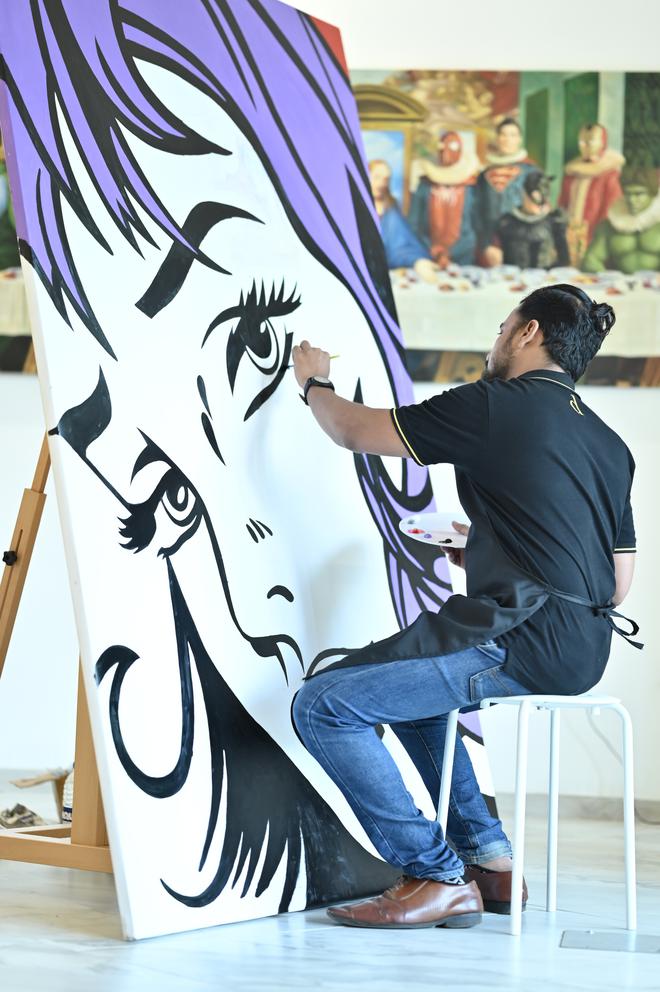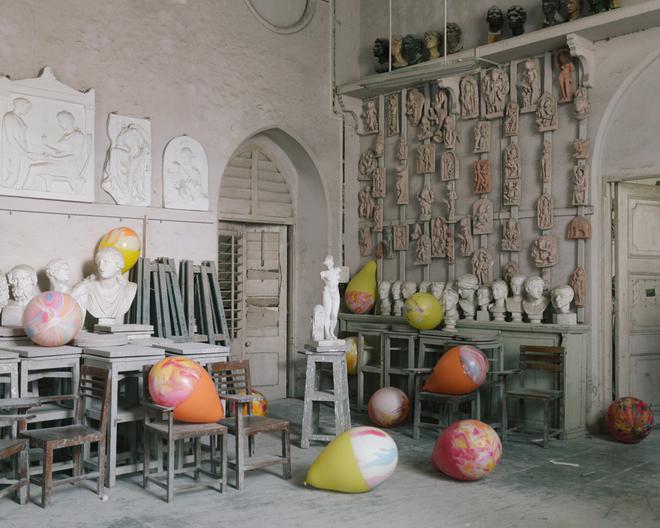A blue bubble-gum blowing Freida Kahlo encased in a 12-inch, pristine white frame; or a time-travelling ‘art astronaut’ donning Van Gogh’s famously teal-coloured ‘Almond Blossom’ except in vivid pink hues holding a balloon; or a melded cross-section of comic book covers and film posters: are these India’s answer to pop art?
While art is subjective, these pieces at the first physical pop art gallery in India, The Designera in Mumbai launched early this year, may not have found gallery space a few years ago. But, as more galleries tailored specifically to cater to younger audiences crop up across the country, collecting is changing from being a luxury sport to a more personal activity.
The Art Basel and UBS Global Art Market report 2022 cites that millennials constitute 52% of High Net Worth (HNW) individuals engaged in art collecting. The report’s prediction for the next year also tracks a growing interest in digital art, especially among younger collectors. “A small number of young collectors spent significant amounts on digital art, with 5% of Gen Z and 4% of millennial HNW collectors having spent over $1 million,” the report says.
“In the last five years, there has been an active effort to support young artists and bring them to the global platform. Tarq/Gallery XXL in Mumbai, BluePrint 12 in New Delhi, Method, Kala Ghoda …run by young blood — in their late 20s and early 30s who have perhaps studied art — these spaces are not restricted to oil on canvases or bronzes,” says Natasha Jeyasingh, a collector and the curatorial lead for the digital art platform TheUpsideSpace. She also runs Carpe Arte, a group that organises studio visits, talks, and gallery walkthroughs in Mumbai in a bid to support emerging talent, and bring new audiences to the market.

The average Joe
The average young collector in India is between 35 and 39 years of age. “The group of new age art collectors is very dynamic. While predominantly in their late thirties to forties, this collective represents a blend of backgrounds. Some continue family traditions of art collecting, while others are budding collectors embarking on their first ventures into the art world,” says Ankita Talreja, vice president - client relations of Mumbai-based AstaGuru Auction House. “They are usually those who have the capacity to spend an average of seven to 10 lakhs on art in a year,” says Farah Siddiqui of CultivateART, a Delhi-based platform that encourages a nexus between young collectors and emerging talent. The collective represents Viraj Mithani, Hashim Badani, Latika Nehra, Puja Mondal and Arvind Sundar among a roster of other artists.

“I started my career at 24 by curating exhibitions. There came a time when my own friends questioned my preoccupation with the masters and asked me for recommendations for young affordable artists,” says Farah.
Young collectors are very open, and not focussed only on the canvas, and are curious about what they choose to own. More exposure also means more awareness about both what is on the canvas, and the idea behind it. “They are agnostic to the idea of picking up a traditional canvas. They are collectors who buy photography, sculptures, ceramics…,” adds Farah. Moreover, young individuals are viewing art collecting as a means of showcasing their personality.
AstaGuru’s Collectors Choice Auction is popular because of its unique format of no reserve (with no minimum price set), where bidding begins at ₹20,000. The auction estimates are set low to foster a gateway for young and new collectors to initiate their art collection journey, says Ankita.
“It has also been observed that young buyers are keen to experiment with their first collections. Some investors are drawn to the potential of acquiring artworks by emerging or mid-career contemporary artists who have the potential to achieve greater recognition and value in the future,” says Ankita. “In addition, a small group also constitute those who are not particularly art connoisseurs but new home buyers,” says Amrita Deora, founder of The Designera. The pop art gallery has capped their artworks at a maximum price point of ₹5 lakhs.
But as for Natasha, who acquired her first piece worth ₹25,000 at the age of 26 — her monthly salary was ₹25,000 at the time — over several monthly installments, it was all about affordability. Natasha calls herself an accidental collector. She does not come from a background that actively spends money on art.
“I have always sought to collect young, emerging artists because I like to be able to have conversations with the artists and know a bit about them, and understand their practice. I also believe that this is when they need the support.”
Moreover, with social media, artists are able to build their own audiences. Santanu Hazarika who has been an artist for the last decade says that it took him six to seven years to reach a decent level of exposure. “Through social media, one can actually study what kind of interaction is associated with which kind of art. What worked for me, is being able to be completely honest with my work,” he says. Santanu sees a lot of direct enquiries by peers and collectors that mostly come through social media. “It is now a marketplace to capitalise on potential clients. They not only see your artwork, but they also see your whole journey and process. What works for the current generation and millennials is personalisation.” He believes that the artist-collector relationship is increasingly becoming “co-dependent.”
“[Young collectors] are presented with the possibility of owning a piece of art by someone who has the same political, ecological, emotional and lifestyle concerns as them”Umah Jacobdirector of external relations and outreach, India Art Fair
Artworks inspired by pop and comic book culture is very popular now, says Santanu. “Most of the collectors go for one-on-one objects, like a pair of customised sneakers. The utility of the artwork is very intriguing to the young collectors.” As the earning power increases, young collectors tend to go back to their younger selves, says Santanu. Pieces inspired by popculture of their childhood garners great interest. Customised figurines and toys, apart from wearable art (on clothing and shoes) are widely popular among millennials.
Art intrinsically holds value in itself but the value of an artist comes down to their net worth…who owns their work, sells their work or is talking about their work, and which are the residencies they have attended. Says Natasha, “In a fine art market, there was a lot of gatekeeping by galleries and other players. That sort of gatekeeping has moved, and artists are building their own worth, which in turn pushes the galleries to show their work.” This has happened with artists like Santanu, Osheen Shiva, Pooja Mondal who have built strong portfolios on Instagram.
Fostering a community
As for those who are looking to collect, new avenues open up every now and then in the form of curated lifestyle events where art is rightly portrayed as a cultural fabric, more than a commodity for investment. To that end, special curations like Young Collectors’ Weekend, Art Night Thursdays (a practice where galleries remain open for more hours every second Thursday of the month for working people to drop in), and Young Collectors Hub are organised to draw in a younger, urban crowd who might be interested in collecting in metro cities. These curations, though centred around art, are often peppered with performances, interactive workshops, and food stalls, and most often transform into social events, another big up for networking within the art market.

The India Art Fair 2023 in Delhi, for instance, saw a true bounce-back after the pandemic. “We had a dedicated programme called the Young Collectors’ Programme, which we have been running for the last three years, that encourages young people to engage with art. The whole idea is to encourage young individuals to support their peers,” says Umah Jacob, director of external relations and outreach.
She believes that in the past few years, young individuals in India have been more concerned with culture and the arts and something that speaks to their generation. While the Art Fair’s Young Collectors’ Weekend saw active participation of late millennials, the actual buying happens within those in their early 40s.
“Suddenly, you are also realising that there is art available at the price point that is similar to the amount that you might spend on a vacation or an expensive handbag,” says Umah, adding, “They are also presented with the possibility of owning a piece of art by someone who has the same political, ecological, emotional, lifestyle concerns as them.” Those who engage grow up to be buyers in the future.







